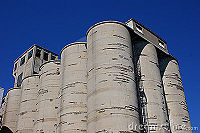Difference between revisions of "Concrete Silos"
Jump to navigation
Jump to search
(Created page with "Category:Silos, Hoppers{{Knoppen}} <noinclude><!------------------------------------------------ * READ THIS FIRST * Only edit this page if you can improve the content. * Im...") |
PurplePen19 (talk | contribs) |
||
| Line 7: | Line 7: | ||
* Please start editing this page after the /noinclude | * Please start editing this page after the /noinclude | ||
* -------------------------------------------------></noinclude> | * -------------------------------------------------></noinclude> | ||
This | [[File:Concrete silos.jpg|thumb|200px|right|Concrete silos]] | ||
'''Concrete silos''' are best for construction projects over 65’ in diameter. They are formed from a continuous, monolithic pour of the concrete walls, which creates a smooth, continuous outer appearance. The need for a continuous pour necessitates a 24 hours per day schedule, including nights and weekends, until the silo is completed. This contributes to a possible 20% increase in overall costs over construction techniques under 65' in diameter. | |||
==Common Advantages== | |||
*can be designed to resist abrasive wear | |||
*withstand impact loads | |||
*provide environmental protection for the product stored | |||
*have no height limitations | |||
*provides a smaller footprint than flat storage | |||
*have a large storage capacity | |||
*have faster unload rates for side discharge | |||
*eliminate payloader expense, maintenance costs, and reduce labor costs | |||
*secure placement and storage of equipment on the silo roof | |||
==Video== | |||
<youtube>V-yG0zdsnYE</youtube> | |||
Latest revision as of 02:04, 21 September 2012
Concrete silos are best for construction projects over 65’ in diameter. They are formed from a continuous, monolithic pour of the concrete walls, which creates a smooth, continuous outer appearance. The need for a continuous pour necessitates a 24 hours per day schedule, including nights and weekends, until the silo is completed. This contributes to a possible 20% increase in overall costs over construction techniques under 65' in diameter.
Common Advantages
- can be designed to resist abrasive wear
- withstand impact loads
- provide environmental protection for the product stored
- have no height limitations
- provides a smaller footprint than flat storage
- have a large storage capacity
- have faster unload rates for side discharge
- eliminate payloader expense, maintenance costs, and reduce labor costs
- secure placement and storage of equipment on the silo roof
Video
